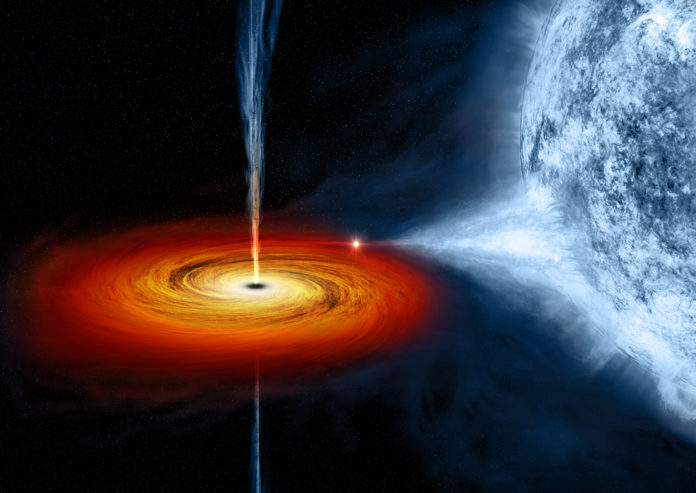A decades-long debate about the existence of black holes was ended in the early 1970s with the discovery of Cygnus X-1: a binary system made up of a supergiant star and the black hole companion that’s slowly devouring it. This discovery — aided by research from the late Tom Bolton, a former professor emeritus at the University of Toronto — kickstarted the field of black hole observations, which recently resulted in the first ever image of a supermassive black hole.
Now, nearly five decades after its discovery, Cygnus X-1 is back in the spotlight. New observations of the first black hole ever detected have indicated that it’s much larger than previously thought, leading astronomers to question long-standing beliefs about the formation and evolution of stellar-mass black holes.
The observations were published in Science, and included contributions from the University of Alberta.
The black hole remnant of a massive star
Black holes are regions where large amounts of mass are packed into very small spaces, resulting in incredibly strong gravitational fields — so strong, in fact, that not even light can escape if it gets too close.
Today, astronomers know of many different types of black holes: from the supermassive black holes located at the centres of galaxies, to the mysterious intermediate-mass black holes first concretely discovered late last year, to stellar-mass black holes that form when massive stars end their lives and collapse inwards to a point approaching infinite density.
Cygnus X-1 falls into this last category. The black hole was formed when one star in a binary star pair reached the end of its life and collapsed inwards, leaving only a black hole remnant behind.
Astronomers believe that the black hole in Cygnus X-1 is currently stripping material off of its still-living stellar companion, forming an accretion disk of hot matter around the black hole and powering massive jets that shoot out of either end.
Cygnus X-1 is further than it appears
In the early 1970s, astronomers measured the distance from the Earth to Cygnus X-1 to be approximately 6,000 light years. However, these estimates were highly uncertain, and some astronomers believed the distance to be as large as 7,800 light years. Most of these estimates were based off of indirect methods that weren’t able to provide conclusive results — for example, one team of astronomers hypothesized that the Cygnus X-1 system might be part of a nearby group of stars, and used distance estimates to that group of stars in order to infer a distance for Cygnus X-1.
Using these uncertain distance estimates, along with measurements of the stellar companion’s brightness, they were able to estimate the mass of the stellar companion and infer the mass of the black hole.
Their initial measurement of roughly 15 times the mass of our Sun was in line with what astronomers have long believed about how stellar-mass black holes form. While the massive stars that collapse to black holes can be hundreds of times heavier than our Sun, strong stellar winds that are present around these massive stars should blow off most of this mass over time, resulting in a much lower mass by the time the star collapses into a black hole.
But new observations from the Very Long Baseline Array, or VLBA, in the United States have challenged what astronomers thought they knew about this system. By combining data from 10 observing stations located throughout the United States, the VLBA uses a technique called very long baseline interferometry to measure astronomical distances with extremely high precision.
“If we can view the same object from different locations, we can calculate its distance away from us by measuring how far the object appears to move relative to the background,” explained James Miller-Jones, a professor at Curtin University and the International Centre for Radio Astronomy Research and lead author on the paper in a press release.
“If you hold your finger out in front of your eyes and view it with one eye at a time, you’ll notice your finger appears to jump from one spot to another. It’s exactly the same principle.”
Using this technique, the team was able to determine that Cygnus X-1 is actually located at a distance of 7,200 light years, which is more than 1,000 light years further away than previously thought. This updated distance also implies that the stellar companion is much brighter than astronomers believed — and if that’s the case, the star must also be much more massive than previous calculations indicated.
This updated stellar mass implies that the black hole must be more massive, too. Otherwise, it wouldn’t be able to have such a strong gravitational effect on its massive companion star.
Armed with these updated measurements, the team recalculated the black hole’s mass to be a whopping 21 times the mass of our Sun, which is a 50 percent increase on their previous estimate. A mass this large shouldn’t be possible for a stellar-mass black hole, leading astronomers to wonder if they may be missing a piece of the puzzle when it comes to black hole formation.
Could stellar winds be weaker than expected?
While astronomers have long believed that stellar winds produced by massive stars are extremely powerful — a billion times stronger than those produced by low-mass stars, to be exact — one possible explanation for Cygnus X-1’s unusually large mass could be that these winds are actually weaker than expected.
“Stars lose mass to their surrounding environment through stellar winds that blow away from their surface,” explained Ilya Mandel, a professor at Monash University and the ARC Centre of Excellent in Gravitational Wave Discovery (OzGrav), and co-author on the paper.
“[T]o make a black hole this heavy, we need to dial down the amount of mass that bright stars lose during their lifetimes.”
Techniques like very long baseline interferometry, combined with the new field of gravitational wave observations, will allow astronomers to begin detecting and studying more black holes than ever before. Doing so will help to shed a light on the formation and evolution of these mysterious objects.









































